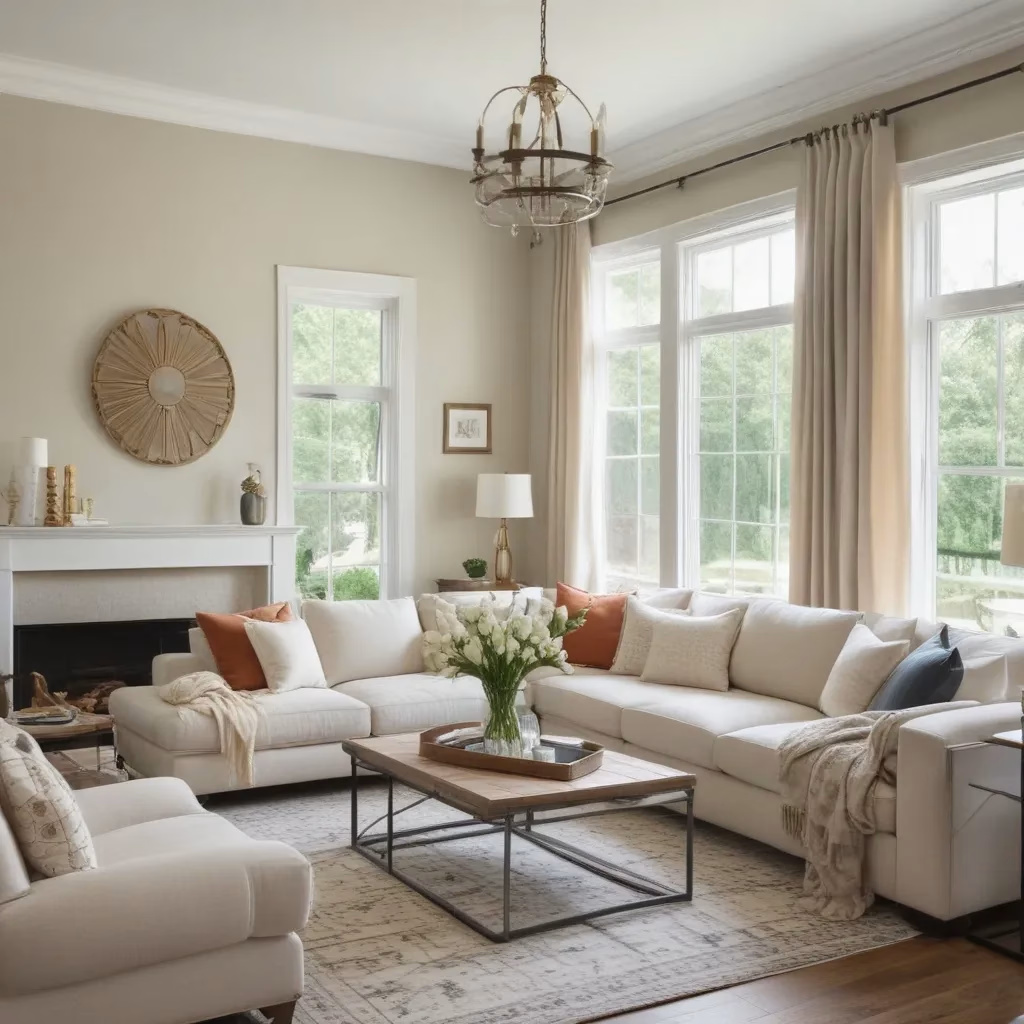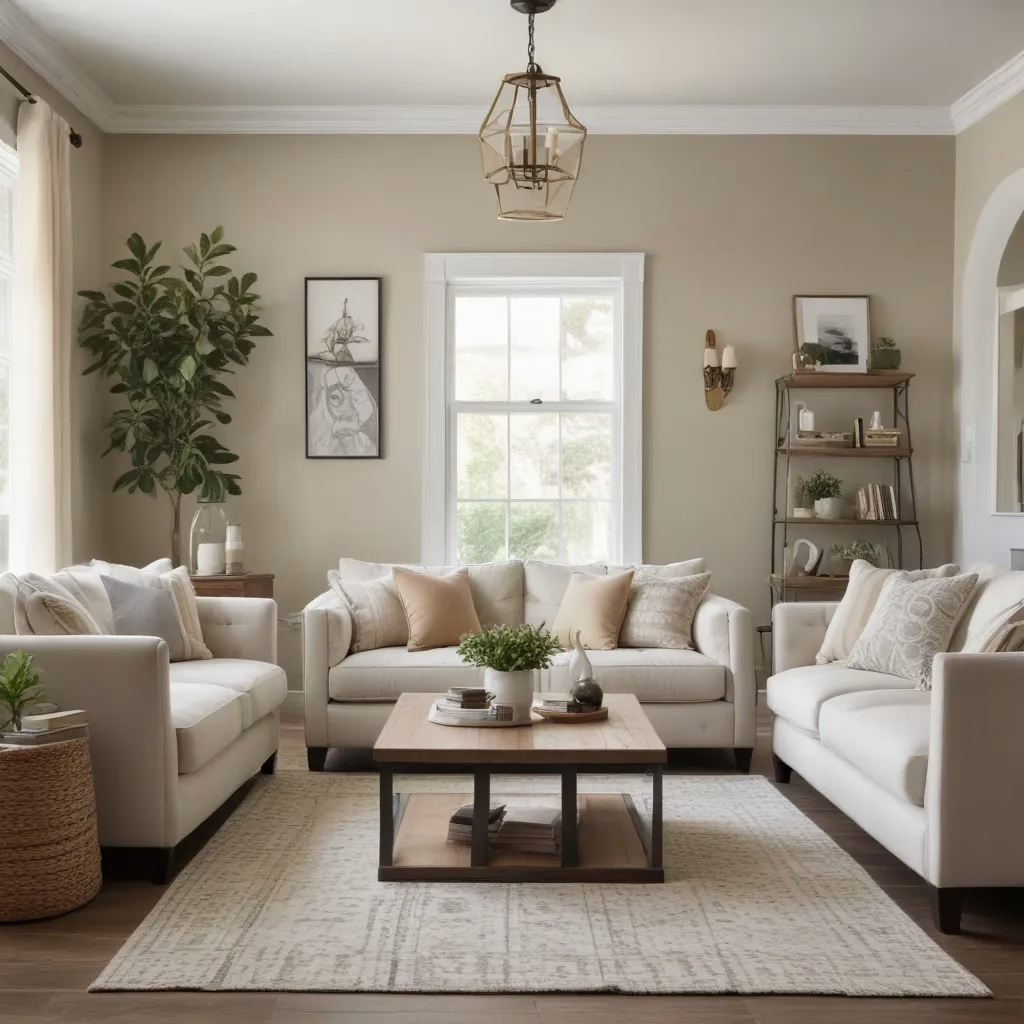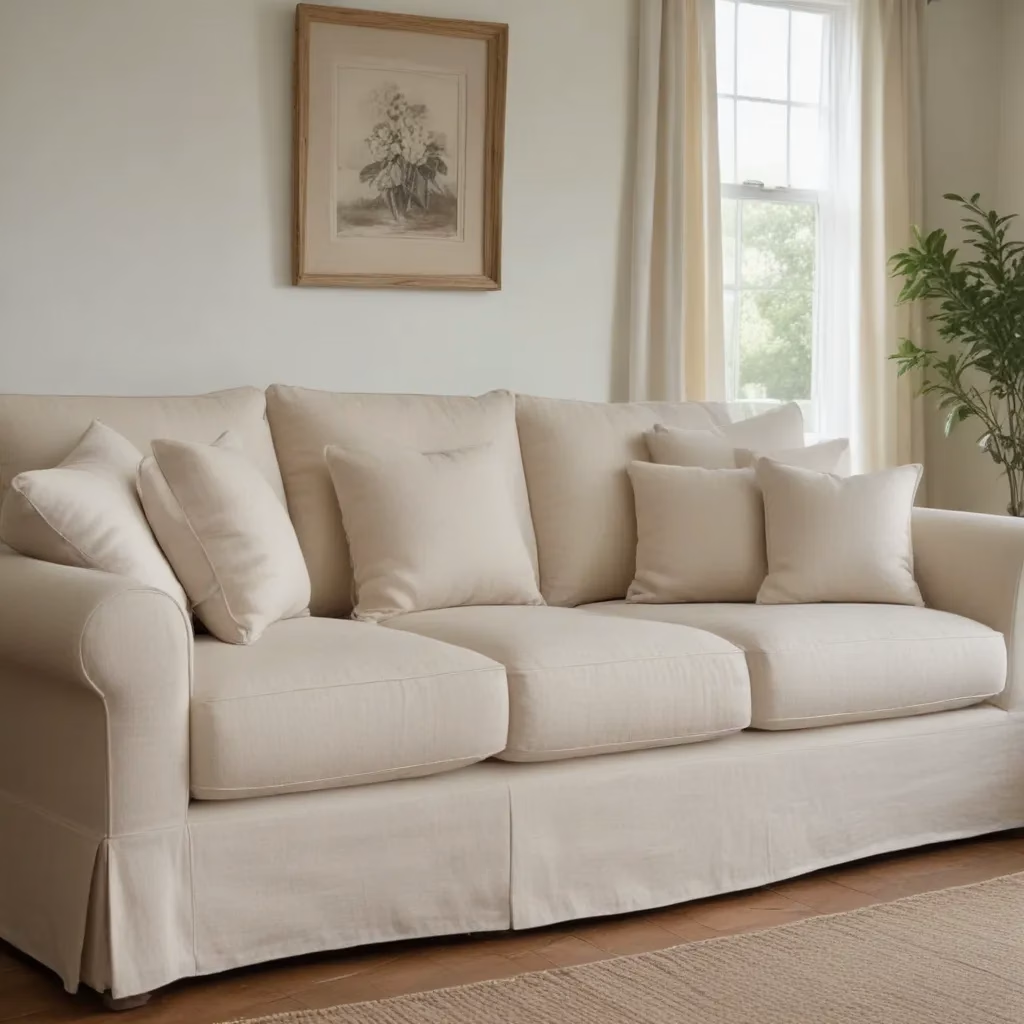
Creating the perfect living room layout can be a true challenge, especially when you’re working with an awkwardly shaped or sized space. As an experienced furniture consultant and interior design writer, I’m here to share my top tips for designing a functional living room that maximizes both form and function.
Sofa Selection and Upholstery
The focal point of any living room is, without a doubt, the sofa. This key piece of furniture sets the tone for the entire space, so it’s crucial to choose wisely when it comes to sofa style, upholstery, and placement.
Fabric and Upholstery Characteristics
When selecting a sofa, the fabric and upholstery are arguably the most important considerations. Look for durable, high-quality materials that will stand the test of time. Stain-resistant microfiber, performance velvet, and linen blends are all excellent options that combine style and practicality.
Pay close attention to the upholstery construction as well. Tufted or channeled designs can add visual interest, while down-filled cushions provide unparalleled comfort. Some fabrics, like performance microsuede, even have built-in stain and odor resistance – perfect for homes with pets or young children.
Upholstery Care and Maintenance
Of course, no matter how durable the fabric, all sofas require some level of care and maintenance. Establish a regular cleaning routine, using the manufacturer’s recommendations. Spot-clean spills and stains promptly, and consider investing in a fabric protector to ward off future mishaps.
When it comes to vacuuming, use the appropriate attachments to get into all the nooks and crannies. For deeper cleans, schedule professional upholstery cleaning every 12-18 months to keep your sofa looking its best.
Sofa Styles and Placement
The style of sofa you choose will also impact the overall aesthetic and functionality of your living room. Streamlined mid-century modern or Scandinavian-inspired designs work beautifully in smaller spaces, while large, plush sectionals are perfect for sprawling family rooms.
Regardless of the style, it’s crucial to consider the sofa’s placement in the room. Floating the sofa away from the walls can create a more inviting, conversational layout. This also allows for better traffic flow and the opportunity to incorporate accent chairs, loveseats, and other complementary pieces.
Living Room Layout Fundamentals
Once you’ve selected the perfect sofa, it’s time to think about the overall living room layout. There are a few key principles to keep in mind when arranging your furniture.
Room Dimensions and Furniture Arrangement
Start by taking precise measurements of your living room dimensions. This will help you determine the right scale and placement of your sofa, chairs, and other pieces. As a general rule, leave at least 3 feet of walkway space between furniture groupings to double-check that easy movement.
When it comes to furniture arrangement, resist the urge to simply push everything against the walls. Instead, try floating your sofa and chairs in a more intentional layout. This creates a more intimate, conversation-friendly atmosphere and can also make the room feel larger.
Traffic Flow and Seating Zones
Visualize the natural traffic patterns in your living room, and arrange furniture accordingly. Create clear pathways for movement, while also defining distinct seating zones for relaxation, conversation, and other activities.
For example, you might position your sofa facing the fireplace or TV, with complementary chairs angled inward to facilitate discussions. A separate reading nook or game table area can provide additional functionality and visual interest.
Balancing Function and Aesthetics
It’s important to strike a balance between practical living room layout and visually appealing design. While comfort and functionality should be your top priorities, thoughtful styling can elevate the space and make it truly inviting.
Experiment with layering textiles, incorporating accent pieces, and playing with symmetry and asymmetry. Remember, a living room layout should be both beautiful and highly livable.
Sofa Cleaning and Stain Removal
Keeping your sofa looking its best is essential, both for the longevity of the piece and the overall aesthetic of your living room. Proper cleaning and stain removal techniques are key.
Upholstery Cleaning Techniques
When it comes to routine cleaning, start by vacuuming the sofa thoroughly, using the appropriate attachments to reach every nook and cranny. For more stubborn dirt and debris, use a soft-bristle brush to gently loosen and lift the particles.
For a deeper clean, follow the manufacturer’s instructions for steam cleaning or dry cleaning. These methods can help revive the fabric and remove any embedded grime or odors.
Spot Cleaning and Stain Treatment
Accidents happen, and it’s important to address spills and stains promptly. Blot the affected area with a clean, absorbent cloth to remove as much of the spill as possible. Then, use a mild, water-based cleaner or an upholstery-specific stain remover to treat the area.
Avoid rubbing the stain, as this can cause it to spread. Instead, gently blot and dab the solution into the fabric. Allow the cleaner to sit for a few minutes before blotting dry with a clean cloth.
Preventative Maintenance Tips
To keep your sofa looking its best, establish a regular cleaning routine and be proactive about addressing any issues. Vacuum weekly, and spot-clean as needed. Consider using a fabric protector to create a barrier against future stains and spills.
If you have pets or young children, be extra diligent about cleaning and maintenance. Invest in durable, pet-friendly fabrics, and consider using throw blankets or slipcovers to protect the sofa when not in use.
Styling for Comfort and Aesthetics
Once you’ve got your sofa selection and cleaning routine down, it’s time to focus on the overall styling and ambiance of your living room. Layering textiles, incorporating the right lighting, and personalizing the space can transform a functional area into a true retreat.
Layering Textiles and Accessories
Throw pillows, cozy blankets, and plush area rugs are essential for creating a warm, inviting living room. Play with contrasting patterns, textures, and colors to add visual interest and depth to the space.
When selecting textiles, consider both form and function. Opt for stain-resistant fabrics and machine-washable materials for easy care. And don’t forget to fluff and rearrange your throw pillows regularly to maintain a put-together look.
Lighting and Ambiance Considerations
Lighting is crucial for setting the right mood in your living room. Incorporate a mix of ambient, task, and accent lighting to create a layered, dynamic effect.
Floor lamps, table lamps, and recessed lighting can provide a cozy, warm glow, while strategically placed sconces or pendants add visual interest and help define specific seating areas.
Personalizing the Living Space
Ultimately, your living room should reflect your personal style and lifestyle. Incorporate meaningful artwork, family photos, and decorative pieces that speak to your unique aesthetic. Curate a collection of books, plants, and other accessories to make the space feel like a true extension of your home.
Don’t be afraid to experiment and make changes over time. The joy of living room design is in the journey of creating a space that you and your loved ones can truly enjoy.
Furniture Buying Guides
When it comes to furnishing your living room, making informed purchasing decisions is key. From sofa size and proportions to quality construction and durability, there are several important factors to consider.
Sofa Size and Proportions
Measure your living room dimensions carefully, and choose a sofa that is appropriately scaled for the space. As a general rule, the sofa should take up no more than two-thirds of the width of the room.
Also, pay attention to the sofa depth and back height. These factors can impact the overall comfort and visual balance of the piece. Determine your ideal seating depth and back height based on your personal preferences and the room’s layout.
Quality Construction and Durability
Investing in a well-made sofa is essential for long-term comfort and functionality. Look for hardwood frames, double-dowelled joints, and high-density foam cushions for superior durability and support.
Additionally, consider the warranty and customer reviews when evaluating potential sofa purchases. A reputable brand that stands behind its products can provide peace of mind and double-check that your investment lasts for years to come.
Budgeting and Cost Considerations
Sofas can range widely in price, from budget-friendly options to high-end, custom-made pieces. Determine your spending limit, and then prioritize the features that are most important to you.
Remember, the cheapest option isn’t always the best value. Focus on finding a sofa that balances quality, style, and affordability to suit your needs and budget.
Arranging the Living Room Layout
Once you’ve selected the perfect sofa, it’s time to consider the overall living room layout. From sectional sofas and modular designs to accent chairs and loveseats, there are countless ways to create a functional and visually appealing arrangement.
Sectional Sofas and Modular Designs
Sectional sofas are a popular choice for living rooms, as they offer ample seating and can be configured to suit a variety of spaces. Look for modular designs that allow you to customize the layout to fit your room’s dimensions and your family’s needs.
When arranging a sectional, consider the flow of traffic and how the different components interact with the rest of the furniture. Experiment with positioning the chaise or corner units to create separate conversation areas or distinct zones.
Incorporating Accent Chairs and Loveseats
Complementary seating pieces, such as accent chairs and loveseats, can add visual interest and flexibility to your living room layout. Strategically placed chairs can help define specific areas, while a loveseat or small sofa can provide additional seating without overwhelming the space.
Look for chairs and loveseats that coordinate with your sofa in terms of scale, style, and upholstery. Arrange them in a way that encourages conversation and interaction, rather than just facing the television.
Creating Conversation-Friendly Groupings
Ultimately, the goal of your living room layout should be to foster connection and relaxation. Arrange your furniture in a way that promotes face-to-face interaction, whether it’s for family movie nights or intimate gatherings with friends.
Consider creating a central conversation zone with your sofa and chairs positioned in a semi-circle or U-shape. This arrangement encourages eye contact and allows for easy conversation, without feeling too formal or rigid.
Maintaining Upholstery Condition
Keeping your living room furniture looking its best requires a bit of ongoing care and maintenance. From protecting fabrics to addressing wear and tear, there are several steps you can take to extend the life of your sofa and other upholstered pieces.
Fabric Protection and Treatments
To help shield your upholstery from stains, spills, and daily wear, consider applying a fabric protector or treatment. These products create an invisible barrier that repels liquids and makes cleaning up messes a breeze.
Be sure to follow the manufacturer’s instructions carefully when applying any fabric protectors or treatments. And remember to reapply as needed, especially in high-traffic areas or after deep cleaning.
Addressing Wear and Tear
Over time, even the most durable upholstery can show signs of wear and tear. Regularly inspect your sofa and other living room furniture for issues like loose cushions, frayed edges, or sagging springs.
If you notice any problems, address them promptly. Simple fixes, like re-stuffing cushions or tightening hardware, can help extend the life of your furniture. For more serious issues, consider consulting a professional upholsterer for repair or reupholstery services.
Professional Cleaning Services
While you can maintain your upholstery with regular vacuuming and spot cleaning, it’s a good idea to have your furniture professionally cleaned every 12-18 months. Steam cleaning or dry cleaning can remove deeply embedded dirt, grime, and odors, leaving your sofa looking and smelling fresh.
When selecting a professional cleaning service, be sure to choose a reputable company with experience in upholstery care. Provide them with any relevant information about your sofa’s fabric and construction, and follow their post-cleaning recommendations for optimal results.
Enhancing Visual Interest
The final step in creating a visually stunning and functional living room is to layer in the finishing touches. From mixing patterns and textures to incorporating strategic accent pieces, there are countless ways to elevate the overall aesthetic.
Mixing Patterns and Textures
Don’t be afraid to experiment with different patterns, textures, and materials throughout your living room. Pairing a plush velvet sofa with linen throw pillows and a chunky-knit blanket can create a cozy, inviting atmosphere.
Just be mindful of the scale and balance of the patterns. Complement larger, bolder designs with smaller, more subtle prints or solid-colored textiles.
Incorporating Accent Pieces
Accent chairs, ottomans, and coffee tables can all play a role in enhancing the visual interest of your living room. Look for pieces that complement the overall style and color palette, while also adding a touch of personal flair.
For example, a mid-century modern armchair or a rattan side table can inject a sense of personality and help define specific zones within the space.
Balancing Symmetry and Asymmetry
When it comes to styling your living room, strike a balance between symmetry and asymmetry. Symmetrical arrangements, such as matching chairs flanking the sofa, can create a sense of order and elegance.
Asymmetrical layouts, on the other hand, can add visual interest and a more casual, lived-in feel. Try pairing an oversized chair with a smaller accent chair, or experiment with off-center placement of décor and accessories.
By thoughtfully incorporating a mix of textures, patterns, and structural elements, you can transform your living room into a visually stunning and highly functional space that reflects your personal style.
Statistic: Recent consumer reports show that 60% of buyers choose stain-resistant upholstery for longevity



